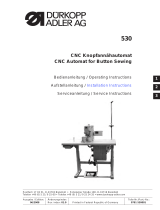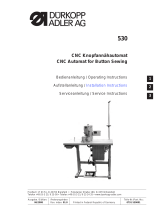1 Product description
1.1 Designated Use
The DÜRKOPP ADLER 580 is a sewing automat designed for the sewing
of buttonholes in light to medium-weight material.
Such material, which is generally made of textile or synthetic fibres, is
used in the clothing industry. Furthermore, this sewing automat can
possibly also sew so-called technical seams. However, in this case the
user has to evaluate the possible risks (preferably in cooperation w ith
DÜRKOPP ADLER) since such applications are rather rare and the variety
of possibilities is vast. According to the result of this evaluation suitable
safety measures are to be taken. Generally only dry fabrics must be
processed with this machine. The material must not be thicker than
8mmwhen compressed by the lowered upper fabric clamps.
The material may not contain any hard objects. The person operating the
automat has to wear finger and eye protection. The sewing automat
must be installed and operated in dry and well-kept rooms only. If it is
operated in other rooms, that are not dry and well-kept further measures
which have t o be agreed upon (see EN 60204-31:1999) can become
necessary. We as manufacturers of industrial sewing automats take it for
granted that at least semi-skilled operators are working with our products
so that we can assume that all usual operations and their risks are known
to them.
1.2 Brief description
The DÜRKOPP ADLER 580 is a double-chainstitch buttonhole
automat or a single-chainstitch automat for stitched eyelets with CNC
step motor technology for the material feed and the rotation of the
sewing mechanism.
The buttonhole automat works with two chainstitch loopers, the left
one being thread-guiding. For the sewing of buttonholes with or
without eye, with taper tack, round tack, cross tack or without
bartacks.
As eyelet automat it works with two chain stitch-blind-loopers for the
sewing of single stitched eyelets.
The automat is equipped with a needle thread trimmer and an
electronically regulated needle thread tension.
Depending on the subclass, the 580 comes with different types of
thread trimmer systems.
Technical features
The automat is driven by a positioning drive integrated in t he machine
arm.
The drive for the motion of the axis X, Y and Z is effected by one step
motor for each axis. These drives are controlled via an electronic
control in conjunction with various pneumatic machine functions.
This drive and control system offers the following advantages:
–
Variable sewing speed according to the sewing parameters
(e.g. needle thread, looper thread, material, seam width)
up to a maximum of 2500 stitches/min.
–
Quiet running (no mechanical switching on and off).
Additional noise reduction by optimized needle bar and looper
drive.
–
The use of step motors allows a very v ariable field of application.
No use of control cams.
5



























